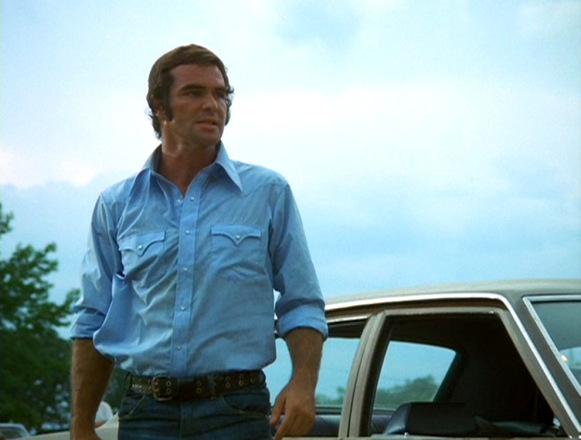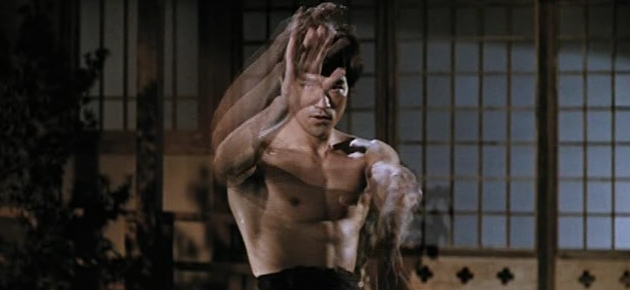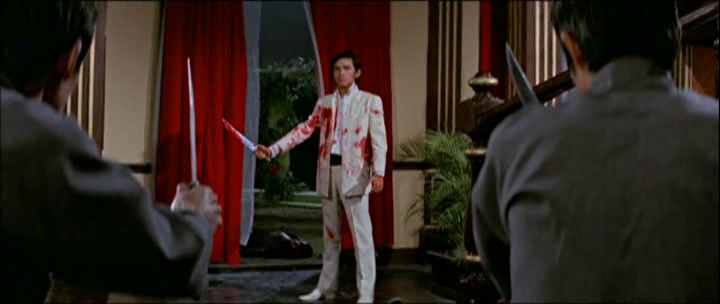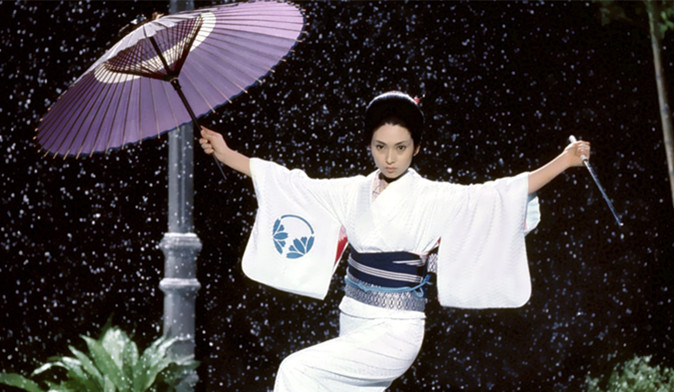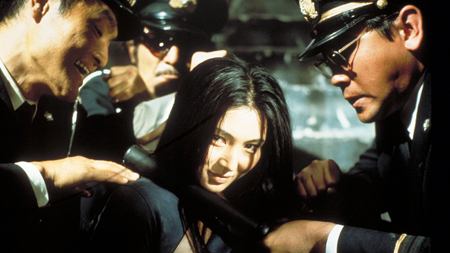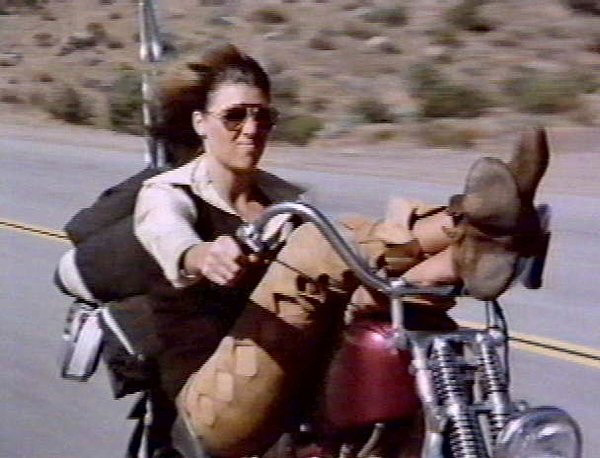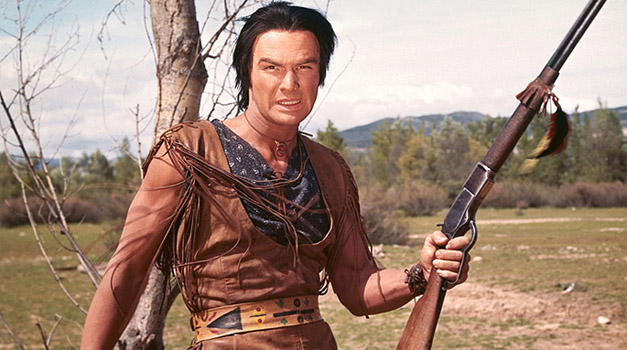9. White Lightning (1973)
Burt Reynolds makes the first of two appearances here, this time in Joseph Sargent’s hixploitation cult favourite, White Lightning (1973). Reynolds stars as “Gator” McKlusky, a bootlegger serving time in an Arkansas prison for running moonshine.
When Gator gets word that his brother has been killed by corrupt Sheriff Connors (Ned Beatty), he brokers a deal with Federal Treasury agents to obtain his release and gather evidence to bring Connors down. Gator returns to running moonshine as his cover, but Connors becomes of suspicious of him, leading to a climactic car chase that settles their fuel-injected feud once and for all.
Reynolds had broken through to major movie stardom a year earlier with Deliverance (John Boorman, 1972), but it was with White Lightning that Reynolds’ star persona first took shape. Reynolds’ Gator is a charming, guffawing good ol’ boy (albeit one with vengeful intentions), tearing across country roads in tire-squealing muscle cars and charming innumerable Southern belles with his mischievous smile.
Kill Bill specially thanks Reynolds in its credits for allowing the use of Charles Bernstein’s score from White Lightning, sampled by the RZA the during the “Showdown at the House of Blue Leaves” in Vol. 1. Bernstein’s spare, off-kilter track serves as a kind of sonic Crip Walk that declares Gator’s grudge over his brother’s death and the impending violence he will enact, and it functions similarly in Vol. 1 as an uneasy, stalking build-up to the Bride’s bloody battle with O-Ren’s henchmen, the Crazy 88.
10. Fist of Fury (1972)
Bruce Lee makes a return appearance to this list with Lo Wei’s Fist of Fury (1972), turning in another performance as an unconquerable martial arts master. Lee plays Chen Zhen, a student who returns to Shanghai to marry his fiancé (Nora Miao) only to discover his former teacher dead and his Jingwu School the target of abuse by the operators and students of a Japanese dojo. After being humiliated and taunted by Wu En (Paul Wei), translator for the dojo’s grandmaster (Riki Hashimoto),
Chen takes on the entire Japanese school, defeating them single-handedly with lightning-fast fists and his righteous offence. Chen discovers his former master’s murderers and kills them, stringing them up on a light post, and then does the same to Wu En. When the Jingwu School is massacred in retaliation, Chen returns to the Japanese dojo for one final act of vengeance before a concluding confrontation with armed police.
Fist of Fury (also known as The Chinese Connection and The Iron Hand) is set in 1920s Shanghai, in the International Settlement where Japanese colonists effectively ruled. The film’s setting provides a jingoistic context for Lee to thrash foreign oppressors and defend his national honor. Lee seethes through Fist of Fury with furious anger, his body in a near content state of iron-like rigidity; an infallible fighting-machine destroying by his actions rivals and peers alike.
The Bride doubly recalls Bruce Lee’s revenge-minded filmography during her battle with the Crazy 88, first by her dress (as discussed above) and second by her intimidation of O-Ren’s gang. The 88 surround the Bride, but flinch in unison at her slight movement, just as the Japanese martial artists do when surrounding Chen.
11. Vengeance (1970)
Tarantino told the UK’s Film 4 that on the recommendation of his fight and stunt coordinator Yuen Woo-ping, he employed a trick of the recently deceased, acclaimed action movie director Chang Cheh – using a condom filled with fake blood to create explosions of gore. Tarantino claimed Cheh supported him from the beyond:
“I swear to goodness, I felt like Chang Cheh talked to me. He came to me and said ‘Hang in there, Quentin! It’s going to work out. It’s bound to explode the right way once.’ Sure enough, four times later, it did it perfectly. And to this day, I’m almost positive that Chang Cheh came to me.”
At the very least, QT went to Chang Cheh by switching the Bride’s battle with the Crazy 88 from colour to black and white, a technique reported to trace back to certain prints of Cheh’s exceptionally brutal revenge film, Vengeance (1970).
Also known as Kung Fu Vengeance and Vengeance!, this predecessor to the kung fu movie craze that followed shortly thereafter is again set during the early Republic of China era of the 1920s and follows David Chiang’s deadly path through the gangsters and thugs responsible for the death of brother, a performer with the Chinese opera.
Cheh’s next-level violence relies heavily on judo and numerous knife-fights, but also employs an artist’s eye, particularly where he cuts Chiang’s brother’s acted stage death against his actual demise from hatchets driven into his stomach. On its US print, Vengeance masks its violence by transitioning to black and white, and by doing the same in Vol. 1, Tarantino provides a visual shout out to one of China’s true masters of action cinema.
12. Lady Snowblood (1973)
The first of two Meiko Kaji films on this list, Lady Snowblood (Toshiya Fujita, 1973) is Meiji-era set revenge tale awash in arterial sprays and intergenerational grudges. Kaji plays Yuki, a young woman born in a prison by a convict whose husband and son were murdered by three men and a woman, then raped and kidnapped until she murdered one of the men and was imprisoned.
Yuki, bearing her mother’s grudge, is born “a child of the netherworlds” and raised to murder the surviving three with a blade hidden within her umbrella. Lady Snowblood is a grimly beautiful revenge film, as poetic as it is bloody, with Kaji’s delicate beauty belying her dangerous and hard-hearted nature.
References to Lady Snowblood abound in Kill Bill, particularly in Vol. 1. The chapter structure of Kill Bill’s narrative directly derives from Lady Snowblood, while the low angle shot of the DiVAS looking down at the Bride in the Two Pines Chapel reproduces the image of the four villains looking down at Yuki’s mother. O-Ren’s murder of Boss Morimoto as revenge for her parent’s death strongly resembles Yuki’s mother’s killing of her kidnapper.
O-Ren’s appearance, her white kimono and tight bound hair, and the wintery garden where she duels the Bride, the artificiality of the snow specifically emphasized, recalls Fujita’s film and its opening sequence where Yuki blocks the snowy path of a rickshaw and murders several men. QT punctuates the Bride’s defeat of O-Ren with “The Flower of Carnage,” the theme song of Lady Snowblood as sung by Meiko Kaji herself.
13. Female Prisoner #701: Scorpion (1972)
Meiko Kaji repeats with Female Prisoner #701: Scorpion (Shunya Ito, 1972), a “women in prison film” that spawned three sequels, all starring Kaji as the cold-blooded Matsu the Scorpion. Used by her narcotics officer boyfriend in a drug sting that resulted in her being gang raped and then thrown in prison when she attempts to kill him on the steps of his police station, Matsu becomes the target of abuse by prisoners and prison staff alike, but Matsu remains unbroken and her indomitable will and clever aggression ensure her revenge is not denied.
After suffering at the hands of her captors and her fellow prisoners, forced to dig without relief and burned by hot miso soup and a mechanic’s lamp, Matsu eventually escapes and has her vengeance, cutting the image of a stylish avenger in a black trench coat and hat.
Ito’s film distinguishes itself from other violent sexploitation films by its inventive cinematography and overtly theatrical sets, making it an ostentatious revenge film unlike any other. Rotating sets, kabuki make-up, sickly green lighting, and evocative stage-sets transform Matsu’s tale of harm and violent reprisal into an extremely unconventional, highly watchable portrait of enacted justice.
Kaji’s piercing glare and icy demeanor is captivating, making her very presence onscreen an act of aggression. Interestingly, Kaji’s discomfort with profanity resulted in Matsu being nearly silent throughout the film. QT concludes Vol. 1 with Female Prisoner #701: Scorpion’s theme, the Meiko Kaji sung “Urami Bushi” (a.k.a. “My Grudge Blues”), Matsu’s song of vengeance and a final statement on feminine revenge.
14. Bury Me an Angel (1972)
In her opening monologue to Vol. 2, the Bride neatly summarizes her actions in Vol. 1 by stating, “When I woke up, I went on what the movie advertisements refer to as a ‘roaring rampage of revenge.'” This evocative little alliteration comes from the actual movie advertisements of Barbara Peeters’ Bury Me an Angel (1972), whose poster describes, “A howling hellcat humping a hot steel hog on a roaring rampage of revenge. In Color.”
Unfortunately, Peeters’ quasi-feminist tale of a female biker avenging the death of her brother barely roars, hardly rampages, and may not even revenge (depending on how its conclusion is interpreted).
Bury Me an Angel stars Dixie Peabody as Dag Bandy, a young woman wracked by sorrow after seeing her brother shot in the face and killed. She sets out on the road with a pair of male sidekicks to track down the murderer and exact her righteous vengeance.
At 6-feet tall (add a few more inches for her tawny mane), Peabody is an imposingly lanky Amazon ready-made for grungy ’70s violence, but Dag’s path of terror across America’s highways and byways is compromised by a series of amateurish interludes that blend hackneyed comedy with clumsy fisticuffs. Wacky bar fights, tiny state troopers, new age witches cooking up marijuana-based stews, and uptight public school officials intervene into Dag’s rampage.
When she ultimately confronts her brother’s killer, her vengeance is muted by an off-screen gunshot that may or may have taken the life of her guilt-ridden target. Bury Me an Angel falls short of its advertising’s promise of raging revenge, although it does follow through on being “In Colour.” Thankfully, Kill Bill arrived 30 years later to roar and rampage in its place.
15. Navajo Joe (1966)
Hated by its star and beloved by Tarantino, Navajo Joe is an unconventional Spaghetti Western that marks the first collaboration between director Sergio Corbucci and composer Ennio Morricone.
Producer Dino De Laurentiis aimed to create his own A Fistful of Dollars (Sergio Leone, 1964), and cast Burt Reynolds as his titular star given his Cherokee ancestry and his TV roles as Native Americans in Gunsmoke and Hawk. Reynolds hated the film, calling it the worst he made and claiming it was shown “only in prisons and airplanes because nobody could leave,” but QT maintains Navajo Joe is “one of the greatest revenge movies and has one of Morricone’s most memorable scores.”
Navajo Joe opens with the massacre of a peaceful Navajo tribe by a gang of vicious comancheros, who then move on to rob the town of Esperanza of a trainload of money. Joe, the mysterious and taciturn title character shadowing the comancheros, is hired by the townspeople to protect their money. Joe eliminates the outlaws one by one, being captured and tortured in the process, and eventually buries a hatchet in the skull of their leader after revealing himself to be the last survivor of the decimated Navajo tribe.
Kill Bill reproduces that axe death during the Bride’s battle with the Crazy 88’s at the House of Blue Leaves, but Navajo Joe is more significantly referenced by two musical selections appropriated for Tarantino’s film – “A Silhouette of Doom,” an ominous and suspenseful track which acts as something like a theme for the Bride’s grudge, and “The Demise of Barbara and the Return of Jack,” which appears during Bill’s eventual death.
16. Coffy (1973)
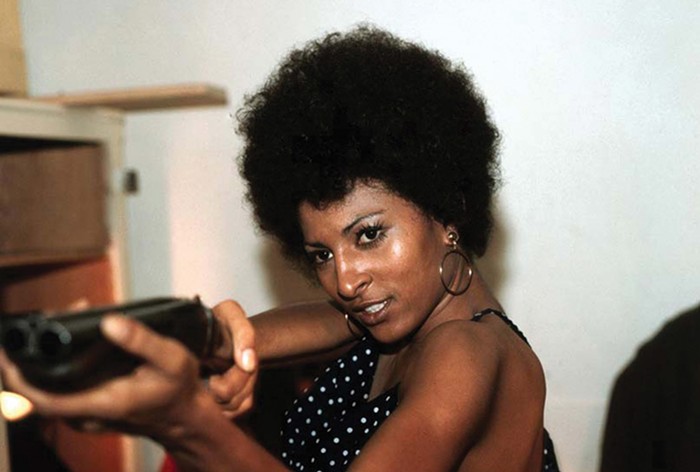
Another Tarantino favorite featuring a female avenger, Jack Hill’s Coffy (1973) stars Pam Grier as the titular nurse out to avenge her sister’s drug addiction and her ex-boyfriend’s murder. Coffy sets her sights on the dealers, pimps, mafia bosses, and corrupt politicians connected to the drug trade, including her own deceitful boyfriend.
Grier’s bosomy vigilante uses her sexuality like a bear trap, confidentially brutalizing her enemies with razorblades hidden in her hair and shotgun blasts to the crotches of her chauvinistic victims.
QT’s admiration for Grier in Coffy and Hill’s Foxy Brown (1974) is obvious, having cast her as his star in Jackie Brown (1997), but his references to the “black-woman revenge movie” in Kill Bill are easily missed. Two cameos in Vol. 2 recall Coffy. The appearance of Sid Haig as a bartender at the strip joint that former Deadly Viper Budd serves his self-imposed penance at recalls Haig’s role in Coffy as a prominent henchman to Mafia boss Arturo Vitroni (Allan Arbus).
Less obvious is the appearance of Jeannie Epper as the Reverend Harmony’s wife during the wedding rehearsal scene at the start of Vol. 2. Epper was a career stunt woman who worked on many of Hill’s movies, including Coffy. Some even go so far as to claim that the line “Come on, bitch!” from the Bride’s knife fight with Vernita quotes a fight between Coffy and a prostitute named Big Harriet (Dea St. Lamont), although perhaps that reaches a bit far.
However, Coffy’s concluding banter with her boyfriend (Howard Brunswick) back at his home does seem to share some resemblance with the Bride eventual meeting with Bill at his hacienda.
